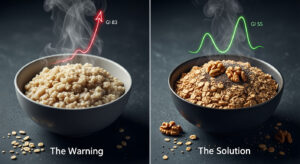The great physician, Hippocrates described that obesity can lead to many health problems. Previously, extra weight was considered as an indication of good health, wealth and prosperity. For many societies, it was a sign of well-being or a symbol of high social status. It took almost two thousand years to test the hypothesis of Hippocrates scientifically and relate it to a significant cause of countless diseases and disorders. obesity is a major contributor of preventable diseases and deaths across the globe.
Obesity: The Nasty Deposits
Obesity is a non-communicable disease that can be defined as an abnormal state of chronic overnutrition. It is characterized by excess fat accumulation in adipose tissues to an extent that results in a significant impairment of health. Increased production of proinflammatory cytokines, insulin resistance and changes in body fat distribution are found to be associated with obesity.
In the last century, obesity turned from a once rare disease into one of the most common diseases. Often obesity is underestimated, to have meager impact on physical health, mental health, social and spiritual aspects. There is a global epidemic of obesity in all age groups in both developed as well as developing countries. This epidemic has resulted mainly from societal factors that promote sedentary lifestyles and consumption of high-fat, energy-dense diets. While genes are important in the determination of a person’s susceptibility to weight gain, obesity results when the energy intake is greater than energy expenditure over a protracted period. The understanding regarding obesity and its types would help in preventing the chances of its occurrence to a great extent.
Classification: Obesity
Obesity is measured by different parameters like body mass index (BMI), waist circumference (WC), waist to hip ratio (WHR), body fat distribution, abdominal fat mass and age. Each of these classifying criteria have its own merits and limitations. These are further explained as under
Body Mass Index (BMI)
BMI is a standard method that correlate the percentage of the body fat with height and is also a surrogate marker for adiposity. Relationship between body fat and height is independently influenced by sex, age and race
Fat Deposition
Fat deposition is mainly seen to occur in abdomen and waist area of obese individuals. When the waist circumference of women is 88 cm and men is 2102 cm, they tend to have abdominal obesity. Body fat deposition can be divided into following types
- Pear Shaped Fat accumulation is more around the hip.
- Apple Shaped High fat deposits in the waist.
- Pear-Apple Shaped The waist to hip ratio is above standard ratio. (approximately 0.85 to 0.90 kg/min males and 0.80 to 0.85 kg/m in females)
- Chilli Shaped These are people with normal BMI (<0.85 in males kg/m and >0.85 in females kg/m).
Age
- Childhood Obesity Excess fat deposition in obese children may be due to genetic, behavioral and environmental factors. Severe obesity is likely to make one prone to myriads of conditions like Diabetes, cardiovascular diseases etc. at a younger age.
- Adulthood Obesity This type of obesity is associated with increased morbidity and reduction in quality of life.
Obesity: The Accompanying Conditions
Cardiovascular Diseases (CVDs)
Excess adiposity, dyslipidemia are well documented risk factors for CVDs. In addition, obesity also increases the risk of High blood pressure. Both adipocytes and macrophages within fat tissues secrete cytokines like IL6, IL-1 and TNF-a that causes localized inflammation. In obesity, excess macrophage accumulation leads to metabolic dysfunction like systemic inflammation and is responsible for the pathophysiological changes in subclinical atherosclerosis. Obesity derived inflammation, insulin resistance, oxidative stress and endothelial dysfunction acts as major drivers that play active part in pathogenesis of CVDs.
Diagnosis
Patient’s history is the initial step in diagnosing of CVDs. Lipid levels of cholesterol, triglycerides and Homocysteine test, and lipoprotein-associated phospholipase A2 (Lp-PLA2) test are primarily analysed. Additionally, imaging
techniques as per the recommendation of a specialist and suitability of the patient for diagnosis of hypokinesia,
akinesia and dyskinesia are also performed.
Type 2 Diabetes
According to “Accelerator Hypothesis” proposed by Prof. Terence Wilkin in 2001, weight gain can possibly cause insulin resistance. Abdominal fat is more lipolytic than subcutaneous in nature, and does not respond to the antilipolytic action of insulin easily, thus, making intra-abdominal fat a more critical risk factor. Excess fat accumulation in visceral tissues inherently diabetogenic) and subcutaneous adipose tissues impair insulin sensitivity by secreting adipokines, especially from liver and muscle tissues. Moreover, chronic overnutrition triggers a vicious cycle of proinflammatory cytokine secretion and suppression of anti-inflammatory substances causing metabolic derangements such as insulin resistance, thereby leading to diabetes.
Diagnosis
The detection of diabetes can be done by screening tests for levels of insulin, C-peptide (for assessment of insulin
secretory reserves), fasting blood sugar (FBS), postprandial blood sugar (PPBS), blood ketone test, oral glucose
tolerance test (OGTT), impaired fasting glucose (IFG), impaired glucose tolerance (IGT) and random blood glucose.
Recently, glycosylated hemoglobin (Hba1c) has been recommended as the gold standard test for diagnosis and
monitoring. Newer test measuring the fructosamine levels in blood is also a promising diagnostic tool.
Cancer Risk
Cancer risk of esophagus, thyroid, colon, kidney, liver, melanoma, multiple myeloma, rectum, gallbladder, leukemia and lymphoma in obesity has been reported. Also, higher rates of prostate cancer in men and breast and endometrium cancer in postmenopausal women are prevalent. The mechanism which may foster cancer occurrence or progression are usually classified as universal and direct in nature. This is because a majority of the tumors arise due to hormonal and metabolic abnormalities seen in obesity. They can be site specific and due to consequential effects of obesity, tumors arise in specific tissues and organs. Adipokines especially adiponectin and leptin has been subject to much study as they may be a factor causing cancer progression and growth. In obesity, oversecretion of proinflammatory molecules (IL-6, TNF-a, leptin, resistin, plasminogen activator inhibitor-1 (PAI-1), hepatic growth factor (HGF)) and hyposecretion of beneficial adipokines (adiponectin and visfatin) occurs. These adipokines are actually from macrophages that infiltrate adipose tissues and resemble human tumor-associated macrophages thereby increasing the expression of FAS gene in cancer cells. Thus, making obesity, a critical risk factor for cancer.
Diagnosis
Detection of cancers through tumor markers like carcinoembryonic antigen (CEA), prostate-specific antigen (PSA),
prostate-specific membrane antigen, cancer antigen 125 (cancer antigen 125) and carbohydrate antigen (Ca-19-9) reflects the
extent (stage) of disease. Thus, help in indicating cancer progression and prognosis. Other methods includes manual
examination (palpation) and imaging techniques.
Gallstones
Obese individuals have excess hepatic secretion of cholesterol and subsequent supersaturation of bile. Abundant fat accumulation increases the risk of cholesterol gallstones by increasing biliary secretion of cholesterol which results in increase of 3-hydroxy-3 methylglutaryl coenzyme A (HMGCOA) reductase activity. Epidemiological studies have found that the lithogenic risk of obesity is strongest in young women while maintaining perfect weight reduces the chances of cholelithiasis. Obese patients have an escalating incidence of benign gallbladder diseases and are at risk of gallstone-related complications. Top causes of morbidity include biliary colic, cholecystitis, choledocholithiasis and pancreatitis.
Diagnosis
Biochemical testing through liver function test, along with a complete blood count test gives valuable information
for hepatocellular damage. Scanning techniques are also used to diagnose abnormalities like cholecystitis.
Osteoarthritis (OA)
Individuals with early adulthood obesity are likely to develop Osteoarthritis. Carrying extra weight imposes more stress on joints that can induce the breakdown of cartilage and accelerate the onset of OA. Increasing BMI initiates a series of events that includes reduced activity, further weight gain and decreased muscle strength, that in turn give rise to degenerative and inflammatory conditions, especially affecting the knees and hip. Another triggering condition for OA may be adipose tissue derived cartilage growth factor or bone factor that can rupture cartilage and affect the joints especially distal radioulnar and metacarpophalangeal joint.
Diagnosis
In physical examination body weight, range of motion in the joint, location of tenderness, muscle strength and ligament
stability are assessed. The global burden of OA has been reduced since the use of inflammatory markers which includes
C-reactive protein, anti-cyclic citrullinated peptide (ACCP test), rheumatoid factor (rheumatoid factor (RF) blood test) antinuclear antibody testing,
Complement 3 test and many more. Synovium fluid analysis, ultrasonography and magnetic resonance imaging (MRI)
are also recommended.
Reproductive Disorders
Males
With increase in BMI, plasma concentration of sex hormone binding globulin (SHBG) and testosterone decreases,
and estrogen level rises. These conditions significantly influence erectile dysfunction and may lead to infertility.
This happens due to the disruption of negative feedback loop of hypothalamic-pituitarygonadal (HPG) axis. Other
hormones involved in the regulation of sertoli cell function and spermatogenesis, such as FSH/LH ratios, inhibin B
and SHBG levels have also been observed to be decreased. One of the demerits of obesity is altered sperm production
due to raised gonadal heat resulting from increased scrotal adiposity.
Females
Obesity induces features of hyperandrogenism, hirsutism, infertility and pregnancy complications of polycystic
ovarian syndrome. The impact of obesity on reproductive function, especially ovulatory disorders, are mainly
attributable to endocrine mechanisms which interfere with neuroendocrine and ovarian functions. It also affects
the HPG axis by increase in free estrogen levels due to increased conversion of androgens to estrogens in adipose
tissue. Increased estrogen causes a decrease in gonadotropin-releasing hormones by negative feedback and results
an irregular or anovulatory cycles in response to negatively impacted HPG axis. It has been found that obese women
have a higher incidence of menstrual dysfunction and anovulation.
Diagnosis
Infertility in females is usually diagnosed by blood tests
that measure abnormal levels of luteinizing hormone, follicle-stimulating hormone, Prolactin, testosterone, insulin
and many more. Semen analysis, blood testing and biopsy are used for evaluation of infertility in males.
Thyroid Disorders
Changes in body weight and thyroid functions are closely related. Excess weight may have negative influence on thyroid gland resulting abnormal functionalities. High values of T3 and FT3 reduces the expressions of both TSH (thyroid stimulating hormone) and thyroid hormones resulting in increased compensatory secretion of TSH and FT3 in an attempt to force a state of peripheral resistance. Also, there is a correlation between BMI and leptin, that is produced by fat cells. Leptin also regulates the TRH (thyrotropin releasing hormone) gene expression in the paraventricular nucleus and TSH in turn stimulating leptin secretion by human adipose tissue. Thus signalling an inverse relation between thyroid hormone and leptin.
Diagnosis
Thyroid disorders can be detected by laboratory testing through complete thyroid panel which tells about abnormal
levels of TSH, T3, FT3, T4, FT4 and antimullerian antibody test (if required).
Respiratory Disease
Obese patients suffer from obstructive sleep apnea, obesity hypoventilation syndrome, dyspnea and are also at risk of asthma. Weight gain and increased BMI leads to decrease in lung volumes, lowered forced expiratory volume per second (FEV1), functional residual capacity (FRC) and expiratory reserve volume (ERV). Moreover, adipose tissue buildup hinders diaphragmatic movement and diminishes basal lung expansion. Further, closure of peripheral lung units causes ventilation-perfusion abnormalities and arterial hypoxemia.
Diagnosis
Laboratory testing determines the working condition of lungs through the measurement of blood gases, CBC and
comprehensive metabolic profile test.
Liver Diseases
Strong links associate liver diseases and obesity which may cause spectrum of abnormalities, ranging from elevation of circulating liver enzyme levels and steatosis to local inflammation (steatohepatitis), cirrhosis and liver failure.
Diagnosis
Biochemical investigation of albumin protein, alanine aminotransferase, gamma-glutamyl transferase and alkaline
phosphate enzymes are necessary for accurate diagnosis
Gout
The prevalence of crystal induced arthropathy is increasing and trend is attributed to obesity epidemic. Successive BMI posses risk of hyperuricemia/gout via elevated levels of serum uric acid. The inflammasome and intracellular machinery related to innate immunity plays an important role in producing interleukin-1a (IL1a) which is responsible for monosodium urate-induced gout inflammation.
Diagnosis
Evaluation of serum Creatinine, uric acid, blood urea nitrogen (BUN) levels and BUN/Serum creatinine ratio through
blood testing helps to identify gout.
Stroke
Obesity is an established risk factor for the development of vascular diseases especially stroke owing to central fat deposition. Attributes like cigarette smoking, heavy alcohol intake and diabetes exaggerate its prevalence.
Diagnosis
Possible biomarkers for stroke risk assessment are LPPLA2 test, N-methyl-D-aspartate neuroreceptors (NMDAR) and
NT-proBNP while, candidates for diagnosis include antibodies to NR2A/2B and metalloproteinases (MMPs)
Mood Disorders
Mood disorders including major depressive disorder, dysthymia, bipolar disorder, generalized and social anxiety disorder, panic disorder and agoraphobia are the most common mental illness. Abnormalities in immunoinflammatory, insulin signaling and counter-regulatory hormones have been explored to contribute their occurrence in an individual.
Diagnosis
For diagnosis of mood disorders, CBC test, kidney profile test, thyroid profile, liver function test, electrolytes profile are suggested.
Is lifestyle to blame?
Several studies has shed light on the relationship between obesity and sedentary lifestyle. Ease in life is increasing day-by-day, owing to automated transportation, liberal access to calorie-dense food, dramatic economic growth in many parts of the world. Majority of the population have become sedentary, with many adults sitting for 70% or more period of their working hours. It has been found that neuromuscular stimulation that occurs during light-intensity activities (standing and walking) and moderate-to-vigorous activity (exercise/yoga and dancing) is necessary to sustain components of musculoskeletal and metabolic health.
Touching on solutions…
Significant reductions in public health and healthcare expenditures could occur around the world if we were able to stem the tide of childhood and adult obesity. Obesity is a complex condition that require an urgent need to be addressed for deeper understanding of the way risk factors interact with each other. One of the reasons why the American Medical Association opted to declare obesity as a “disease” was to give obesity the label that it needs greater attention requiring research, prevention and treatment. Despite many unknowns, we can optimistically address this epidemic named Obesity. While “cure” for this malady may arise someday, the old mantra prevention is the key seems 100% realistic in the case of obesity.
How Can HealthcareOnTime Help You?
Thyrocare offers Obesity profile for qualitative and quantitative analysis of human growth hormone, insulin, follicle stimulating hormone, blood ketones, luteinizing hormones, steroids, cardiac markers using advanced and sophisticated technology at highly affordable rates








